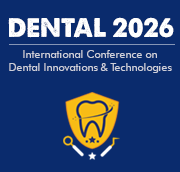Title : Correlation analysis of the shear bond strength and adhesive remnant index in orthodontic adhesive systems: In vitro study
Abstract:
Introduction: The success of orthodontic treatment relies on the durability and strength of adhesive bonds formed between the brackets and enamel, with Shear Bond Strength (SBS) ensuring that brackets remain attached to the teeth, particularly during masticatory movements. However, greater SBS may increase the risk of enamel fracture during bracket or adhesive remnant removal. Meanwhile, the Adhesive Remnant Index (ARI) indicates the amount of adhesive residue left on the tooth surface at the site of bracket bond failure. Minimal adhesive remnants on the tooth surface usually imposes a risk of enamel fracture. Given that both factors are related to the integrity of enamel, this implies that changes in SBS might influence ARI outcomes. Thus, this study aimed to assess a correlation between SBS and ARI scores across two orthodontic adhesive systems.
Methods: 112 extracted human molars were randomly divided into two groups (n=56) for bonding tubes with two orthodontic adhesive systems (Transbond XT and GC Ortho Connect). The shear bond strength (SBS) test was conducted using a universal testing machine. The adhesive remnant index (ARI) was used to evaluate the amounts of adhesive remnants on all molar surfaces. All teeth were analysed by two observers (GK and RV), and to assess the reproducibility of the ARI measurements between them, the inter-class correlation coefficient (ICC) was calculated, indicating a high agreement between the two investigators (0.98; p<0,001). Further statistical analysis was done using Student’s t-test, the chi-squared test, and Spearman’s rank correlation test.
Results: SBS measurements for Transbond XT ranged from 5.48 MPa to 21.51 MPa (mean – 11.76 MPa), while for GC Ortho Connect, they ranged from 5.27 MPa to 18.13 MPa (mean- 11.37 MPa). Higher mean SBS values were obtained with Transbond XT compared to GC Ortho Connect resin; however, it was not statistically significant (p>0.05). In the Transbond XT group, the majority of scores were 0, accounting for 44.23%. Scores of 2 were observed in 21.15% of cases, and 3 in 3.85% of cases. Whereas in the GC Ortho Connect group, all scores were either 0 or 1, with 46.81% and 53.19% respectively. When comparing the two materials, a statistically significant difference was found (p=0.002), with higher ARI scores observed in the Transbond XT group. Six cases of enamel fracture were detected, with no statistically significant difference between the groups (p>0.05). The Spearman correlation test revealed a significant moderately positive correlation (r = 0.427) between SBS and ARI (p<0.001).
Conclusion. The positive correlation between the SBS and ARI indicates that greater bond strength leads to more adhesive residue.
Keywords: Shear Bond Strength, Adhesive Remnant Index, Orthodontic Adhesives



